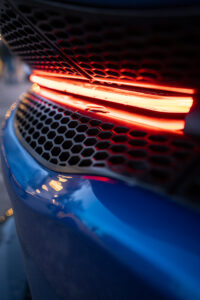The McLaren GT represents a fresh take on the traditional grand tourer formula – can a mid-engined package really work for a car like this?
Does anyone use a grand tourer for grand touring anymore? It seems an impossibly glamorous ideal nowadays – loading up an elegant, spacious and long-legged sports car with luggage and heading for sunnier climes, probably making a stop halfway for an extravagant dinner and a night in a luxury hotel.
The truth is that, even in the era of high-security, post-Brexit-and-Covid air travel, a plane is a much faster and more convenient way of covering this kind of ground. Furthermore, if you’re dead set on driving, modern-day fuel prices and speed limit enforcement mean you might as well pack all your stuff into a diesel SUV or estate car instead. But despite these pesky facts, the romantic ideal lives on, and it’s allowed the notion of the GT car to not only remain, but flourish and diversify.
This diversification has spawned the aptly named McLaren GT. And straight away, something’s off – no long, thrusting bonnet, signifying a huge engine slung out ahead of the occupants in the great grand tourer tradition. That’s because front-engined cars aren’t really in McLaren’s remit. Every production car that the company has built since 2011’s MP4-12C have been based around the same layout: a structural carbon-fibre tub with the engine positioned firmly aft of the occupant’s heads.
And so it is with the GT, McLaren’s mid-engined take on the grand tourer. It shouldn’t work – trying to blend the characteristics of a pointy, aggressive mid-engined supercar with those of the long-range GT should be like trying to make a 100m sprinter run a marathon. Some elements of the mid-engined layout do in fact make a lot of sense in this application, though.
The combination of a short front end and low scuttle provide exceptional forward visibility, and, along with a panoramic roof, allow for a light, airy cabin – a perfectly pleasant place to spend time.
McLarens have long been noted for their glass-smooth rides, and while the GT doesn’t feature the hideously complex cross-linked dampers of the Super Series cars, they are still hydraulic, and softened off considerably in the name of comfort.
Like every McLaren Automotive product from the original MP4-12C until the new Artura, the GT uses a twin-turbocharged V8, here in the 4.0-litre form first introduced in 2017’s 720S. It makes 612bhp, around 100 less than its Super Series sister. Certain elements, like smaller turbocharges and redesigned pistons, are bespoke to the GT, with the intention of taming the peaky, frenetic power delivery of the 720S. These are successful measures, although 612bhp is still a whacking great wedge of power, and the GT surges forward when the turbos wake up.
For extra GT-ness, that long, sloping rear deck lifts up to reveal a surprising amount of luggage space for a mid-engined car.
The GT is a remarkably rounded package – spacious and comfortable, but still properly quick and blessed with McLaren’s gloriously unfiltered hydraulic power steering, providing feedback that’s been dialled out of so many rivals. The big question, though, is whether it stands up in a crowded GT market, where the options for covering big, comfortable distances in a car are wider than ever.
It’s remained a fleetingly rare site on UK roads in the three years since it launched, but it pulls in far more sales in places like the USA and China, where customers tend to place comfort and space high on the list of priorities, so it’s obviously doing something right.
It’s a shame that more haven’t found homes here, as it takes an appealing formula and applies it well. What’s an even bigger shame, though, is how few are likely used for genuine long-distance travel. In this fast-paced world, it feels important to put some of the joy and romance back into travel, and the GT provides a genuinely innovative way of doing this.






























